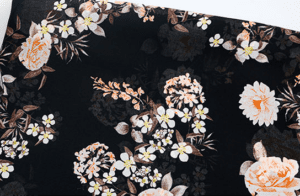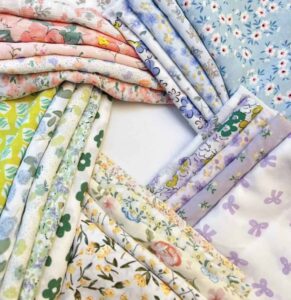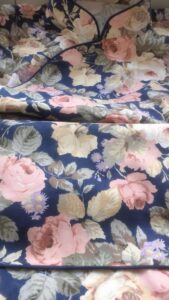Blue printed cloth has a history of more than one thousand years in China, and has an important historical position in the world printing and dyeing history because of its unique style. Printed cloth art in daily life not only decorates our life, but also has rich historical and cultural connotations. Nantong’s blue calico cloth is one of the best. As early as in the Wei and Jin Dynasties, bluegrass printing and dyeing was gradually explored and discovered by ancient workers in Nantong and eventually created bluegrass printing and dyeing technology. The art of blue printing cloth invented on this basis was recorded in Qimin Yao Shu (Qimin Yao Shu). Opium war cannon knocked on the door of China, after one hundred years of China’s traditional agricultural civilization to the western developed industrial civilization, the traditional blue calico art collision to western advanced print technology, nantong blue calico art will fit, is disappearing gradually strong, even more than the west become the leading modern art prints? It’s up to us. Civilization, science and technology, and prints the impact of art ever bring us a painful lesson, but this also can yet be regarded as an opportunity, the modern technology to the modern development of traditional art of nantong blue calico to provide fertile soil, the maturity and improvement of the traditional art of nantong blue calico is for the development of modern nantong blue calico art laid a solid foundation. The further development of nantong blue calico art needs our thinking and practice.
The development course of blue calico art
The development of blue calico art is closely related to the development of blue calico craft. The development of Nantong blue calico art is inseparable from the development of agriculture and industrial civilization in China and the development of China’s comprehensive national strength. Looking back on the development course of nantong blue calico art, it is the development course of ancient Nantong blue calico craft, the learning course of modern Nantong blue calico art, and the progress of ancient Chinese civilization and cultural accumulation.
Budding: Slow development
The development of anti-dyeing printing technology in tang Dynasty created the embryonic form of ancient printing art. Since ancient times, China has had the idea and policy of “valuing agriculture over commerce”. With the development of agriculture, bluegrass dyeing technology has gradually become mature and perfect. In addition, with the development of traditional manual manufacturing, workers in the process of dyeing, also gradually realize the important relationship between dyeing and dyeing prevention, learning to control the integrity of patterns through material control. In the Tang Dynasty, anti-dyeing printing was very popular, and the anti-dyeing technology of mortar alkali agent was created by using lime and grass and wood ash, which was the earliest origin of nantong blue printing art. However, after the prosperous Tang Dynasty, China ushered in various wars in the Song Dynasty, which seriously hindered the spread and development of anti-dyeing technology. In the Southern Song Dynasty, with the development of oil-paper umbrella industry and the prohibition of valerian printing process, intelligent working people invented oil-paper leak-proof printing and dyeing technology, which originated from Nantong and became popular in the South of The Yangtze River, thus opening the era of Nantong blue print art.
Prosperous period: rapid development
The rapid development of textile technology in Ming and Qing Dynasties created the possibility for the rapid development of nantong blue calico art, which ushered in its prosperous period. In the Ming and Qing Dynasties, with the widespread planting of cotton and the general development of cotton textile industry, a broad situation was created for the development of nantong blue print art. At this time, nantong blue calico art gradually spread, has been widely used. In addition, the mature development of technology has caused the reduction of production costs, for the majority of people can use. In addition, nantong people have been planting bluegrass for generations, planting and weaving themselves, which has brought up nantong people’s love for blue printed fabric technology. From this, nantong blue print art and craft gradually flourishing.
With the development of textile technology, various folk workshops have gradually become popular, which is the key to the multi-level and comprehensive development of nantong blue calico art. The independent printing workshop has provided possibilities for the innovation of nantong blue calico artistic patterns and patterns, and enriched the printing and dyeing patterns of the dyeing house. The development of agriculture made the common people gradually rich and happy to wear colorful clothes. Under this condition, dyeing houses gradually emerged. Folk printing and dyeing workers are also common people in general. Although there are differences between different places and individuals, such differences make people communicate, learn and learn from each other, which is conducive to the further innovation of nantong blue calico art. However, in the relatively backward rural and urban areas, dye-shop owners are reluctant to open dye-shops, so a special team of flower-bearers has emerged. This kind of doorscraper and patterned printing technology facilitates the development and popularity of Nantong blue print art in backward areas. The wide use of blue prints and the prevalence of dyeing houses have led to the creation of many large and small family dyeing houses. These home dyehouses are convenient and very popular in the countryside. As the last step in the printing and dyeing process of blue calico cloth, kicking cloth is the last and important process. Therefore produced the professional chuai cloth fang. These textile workshops simplify the steps of dyeing workshops and speed up the process of nantong blue calico technology and art. The development of textile industry and nantong blue calico craft has triggered the emergence and dissemination of various manual workshops in Jiangnan, which have formed the industrial chain and division of labor and cooperation of Nantong blue calico art, making nantong blue calico art enter a prosperous period of rapid development.
Decline period: suffer shock
The western powers opened the door of the Qing government with cannons, and also brought advanced and cheap printing cloth art and technology to the Qing government. Of course, this was simple and easy for the industrially developed western powers, but it severely hit the development of the ancient nantong blue printing cloth art. Nantong blue calico art development also ushered in the impact. The treaty of losing power and humiliation and the forced opening of the door have brought beautiful and complicated machine-woven and machine-dyed cloth to our country. Affected by the impact of foreign textiles and the change of people’s life and habits, nantong blue calico art has suffered a painful impact, gradually shrinking and almost dying out. Lacking the support of the market, the inheritance and development of nantong blue calico art face a serious test.
Renewal period: gradually forward
The economic recovery since the founding of new China, the market development and modernization construction since the reform and opening up have created conditions for the development and prosperity of Nantong blue calico art again. With the development of market economy, people gradually reach a well-off level and begin to pursue spiritual civilization, and nantong blue print art gradually comes into people’s eyes. Nantong blue calico art also gradually received people’s attention. In 2006, nantong blue print printing and dyeing skills were listed as the first batch of national intangible cultural heritage; In 2007, Nantong Blue Calico Museum was awarded the “Inheritance Base of China blue Calico”, thus Nantong became the hometown of China blue calico. At present, the development and innovation of the market have also brought up the development and innovation of nantong blue calico art. People are no longer satisfied with the production of ordinary blue calico, but apply blue calico and its patterns into clothing design, setting off a fashion frenzy of blue calico.
The development strategy analysis of blue calico art under the new situation
Nantong blue calico art has added to our beauty and luster, at the same time, the modernization of nantong blue calico art should also arouse our thinking. Nantong blue printed cloth with fresh and natural blue and white color is not only the product and witness of our ancient farming civilization, but also the cultural heritage we need to inherit. The development of nantong blue print art reflects the wisdom and simplicity of our ancient laboring people, is the embodiment of China’s simple view of nature, is the embodiment of the beauty of harmony and symmetry, and is the precious wealth left to us by history. Therefore, we should inherit and carry forward nantong blue calico art, develop and innovate in the process of inheritance, and form a strategic development system of modern Nantong blue calico art.
Industrial development — an effective measure for the rapid development of blue print art
Nantong blue calico art is accepted and loved by people, but only small-scale workshop production can no longer meet people’s needs, so industrial production will be an effective measure for the rapid development of modern Nantong blue calico art. The “original ecological” Nantong blue calico art has been unable to meet people’s needs and the requirements of economic development, and the original ecological development of modern Nantong blue calico art will generally bring about problems such as resource waste and low labor efficiency in the production process. At the same time, in the declining period of the development of modern Nantong blue calico art in the Qing Dynasty, part of the traditional blue calico and its craft disappeared and the inheritor of the traditional craft was missing. Therefore, the industrialization of modern Nantong blue calico art is an effective measure and inevitable trend of its rapid development.
Review of nantong blue calico art prosperous period of rapid development, we find that the time of the nantong blue calico art industrialization are formed, such as professional cooperation and division of labor, industry textile industry, agriculture and dyeing cloth fang to cooperate, of course the industrialization is relatively young and immature, but also ushered in the nantong blue calico peak in the development of art. Looking back at the history, it tells us that the industrialization development of nantong blue calico art is very conducive to the modernization development of Nantong blue calico art. Industrialization development is a market-oriented operation and development mode of large-scale operation and division of labor. It is a serialized and branded production and operation mode. Facing the market requires the development of Nantong blue calico art to be guided by market demand. For example, modern people prefer “original ecological” Nantong blue calico, we can find the corresponding traditional blue printing pattern and then use modern technology to produce it. Large-scale operation requires that the craft of Nantong blue calico art is no longer the traditional family workshop production, but the large-scale joint production and sales in one, and the large-scale development of Nantong blue calico art. The division of labor and cooperation requires each industrial chain of Nantong blue calico art to divide labor and cooperate with each other, so as to make the best use of everything from production, manufacturing, application and sales, so as to make overall and partial plans. Of course, according to the course of industrialization development, the development of Nantong blue print art is only in the import stage of production technology and industrial research and development, and some companies have not even realized the importance of industrialization. But even if it is difficult, we must go on, because industrialization is an effective way to develop nantong blue calico art. When we pass the difficult second stage, successful industrial production will not be far away. The development stage and stable stage of industrialization is the stage when we get economic benefit and nantong blue calico art develops well and rapidly.
Although the industrialization development is an effective measure for the rapid development of Nantong blue calico art, we should also pay attention to the “original ecological” development of Nantong blue calico art and find the balance between the industrialization development and the “original ecological” development. Because, “original ecological” Nantong blue calico art is not only our intangible cultural heritage, but also the rapid development of nantong blue calico art industrialization market demand. With the “original ecological” Nantong blue calico, the industrialized Nantong blue calico produced by the art craft will be more accepted by people. Therefore, we should not only adhere to the industrialization development of Nantong blue print art, but also pay attention to the balance with the “original ecological” Nantong blue print art in the process of development.
Innovative development — the development approach of blue calico art
Innovative development is the development strategy that nantong blue calico art must always adhere to in the process of development. If there is no innovation, it will be difficult for us to industrialize nantong blue calico art. Even if nantong blue calico art finally forms industrialization development, there will be no innovation in the fourth stage of industrialization development, the industrialization of Nantong blue calico art will fail and the industrial chain will dissipate. Moreover, the disappearance of nantong blue print art in the Qing Dynasty was closely related to the fact that people were gradually satisfied with the low technology at that time and did not know about innovation. Innovation is also based on the traditional Nantong blue calico art that we inherited. It is a process of inheritance, integration and reconstruction, and a new development of Nantong blue calico art.
The innovation of modern Nantong blue calico art can be started from two aspects: one is the innovation of traditional technology; The second is the innovation of traditional patterns. Nantong blue calico art should be combined with modern science and technology, such as digital CAD technology, when it is added to nantong blue calico art, we do not need to worry about the uneven pattern of printing and dyeing. The introduction of workflow technology is no longer the ultra-low labor efficiency in the past. The innovation of the traditional pattern of Nantong blue calico art can not only absorb from the traditional culture and art of Our country, but also add the fashionable elements to create a unique pattern of modern Nantong blue calico art.
Sustainable development — strategic requirement for the long-term development of blue calico art
Sustainable development is an indispensable development strategy in the development of modern Nantong blue print art, and also a choice for the long-term development of modern printing technology. With the development of modern economic globalization, environmental and energy issues have become increasingly serious. The sustainable development of Nantong blue calico art is not only a response to global environmental protection, but also a necessary road for its own rapid development. As the intangible cultural heritage of our country, we should not adopt the development mode of killing the goose that lays the golden egg, only pursue economic benefits and neglect cultural inheritance and development of nantong blue calico art. Therefore, we should adopt sustainable development strategy to develop nantong blue calico art. Moreover, the sustainable development of Nantong blue calico art conforms to the trend of China’s traditional cultural heritage development and economic development.
As one of the basic requirements of our scientific concept of development, sustainable development is an economic model that pays attention to long-term economic growth and development. This development model is obviously very suitable for the development status of Nantong blue calico art. Economic growth is the catalyst for the rapid development of modern Nantong blue calico art, which can make people pay more attention to the application and innovation of Nantong blue calico art. The long-term development is also more convenient for people to inherit and digest the traditional intangible cultural heritage of Nantong blue print art, and promote the wisdom of ancient Chinese workers. Sustainable development should follow the corresponding principles: fairness principle, sustainability principle, harmony principle, demand principle, efficiency principle and step principle. On the one hand, these principles are the requirements for sustainable development; on the other hand, they tell us how sustainable development should be developed and what development strategies should be implemented in what development period. We believe that with the sustainable development strategy, nantong blue calico art and craft will be faster and easier. At the same time, the art and craft of Nantong blue prints should adhere to the strategy of sustainable development, and adhere to the ecological economic mode, that is, to establish an ecological production process with no waste, no pollution and little waste and pollution, and to attach importance to energy conversion efficiency and adhere to the ecological economic operation mode with the combination of natural value and economic value. Such an ecological economic model is a responsibility for China’s environment, which can reduce production costs and expand economic benefits. To sum up, sustainable development is an indispensable strategic requirement for the development of modern Nantong blue calico art.
Conclusion
Nantong blue calico art, as one of the first batch of national intangible cultural heritage, is the pride of Nantong people, we should be proud of it and inherit and develop it. However, to make the nantong blue calico art in the new era and situation to get fast development, in addition to inherit the art tradition of nantong blue calico characteristics, also cannot leave the long-term planning strategy and countermeasures of sustainable development and the development of clear thinking, namely industrialization development, innovative development and sustainable development, Only in this way can we make this traditional arts and crafts glow with modern brilliance.
























